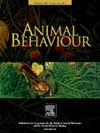Evolutionary influences on multiple paternity in mammals
IF 2.1
2区 生物学
Q2 BEHAVIORAL SCIENCES
引用次数: 0
Abstract
Multiple paternity is a widespread phenomenon, but the underlying factors that influence the considerable variation across species remain unclear. We examined four hypotheses to explain variation in multiple paternity across 98 populations of 60 mammalian species. We tested whether the log-odds of multiple paternity could be explained by sexual size dimorphism as an indicator of male–male competition, habitat used (aerial, arboreal, terrestrial), feeding groups (carnivores, omnivores, herbivores) and male social organization (males living separately from females, groups with one male or groups with multiple males). Phylogeny and intraspecific variation (random effects) of populations accounted for 8% of the total variation in the log-odds of multiple paternity, with phylogeny and variations within species each explaining about 4% of the total variation. The hypotheses and a litter size covariate (fixed effects) accounted for about 85% of the total variation. After accounting for phylogenetic relationships and within-species variation, the log-odds of multiple paternity exhibited a slight increase with sexual size dimorphism, in the opposite direction to what was expected. Spatial dimensions of habitats that species used were strongly supported as an influence on the probability of multiple paternity. Contrary to predictions, trophic levels did little to explain the odds of multiple paternity. Predictions of influences of male social organization on multiple paternity were only partially supported: species whose male social organization was composed of groups with multiple males averaged greater odds of multiple paternity than species whose main male social organization was composed of social units with one male. The probability of multiple paternity in mammals appears to be little influenced by phylogeny or within-species variation. But, it seems likely that several factors play a role in explaining variation in the probability of multiple paternity within and among species, including habitat use and social behaviour.
哺乳动物多重父权的进化影响
多重父权是一种普遍现象,但影响物种间巨大差异的潜在因素尚不清楚。我们研究了四种假说来解释60种哺乳动物98个种群的多重父系差异。我们检验了多重父权的对数概率是否可以用两性大小二态性作为雄性竞争、栖息地(空中、树上、陆地)、摄食群体(食肉动物、杂食动物、食草动物)和雄性社会组织(雄性与雌性分开生活、一个雄性群体或多个雄性群体)的指标来解释。种群的系统发育和种内变异(随机效应)占多父系对数赔率总变异的8%,物种内的系统发育和变异各占总变异的4%左右。假设和窝产仔数协变量(固定效应)约占总变异的85%。在考虑了系统发育关系和种内变异后,多重父权的对数赔率随着性别大小二态性的增加而略有增加,这与预期的方向相反。物种使用的栖息地的空间维度对多重父系的可能性有影响,这一点得到了强有力的支持。与预测相反,营养水平几乎不能解释多重父亲的可能性。关于雄性社会组织对多重父权影响的预测仅得到部分支持:雄性社会组织由多个雄性组成的物种比主要雄性社会组织由一个雄性组成的社会单位的物种平均有更大的多重父权几率。哺乳动物多重父系的可能性似乎很少受到系统发育或种内变异的影响。但是,似乎有几个因素在解释物种内部和物种之间多父性概率的变化方面发挥了作用,包括栖息地的使用和社会行为。
本文章由计算机程序翻译,如有差异,请以英文原文为准。
求助全文
约1分钟内获得全文
求助全文
来源期刊

Animal Behaviour
生物-动物学
CiteScore
4.60
自引率
8.00%
发文量
236
审稿时长
10.2 weeks
期刊介绍:
Growing interest in behavioural biology and the international reputation of Animal Behaviour prompted an expansion to monthly publication in 1989. Animal Behaviour continues to be the journal of choice for biologists, ethologists, psychologists, physiologists, and veterinarians with an interest in the subject.
 求助内容:
求助内容: 应助结果提醒方式:
应助结果提醒方式:


